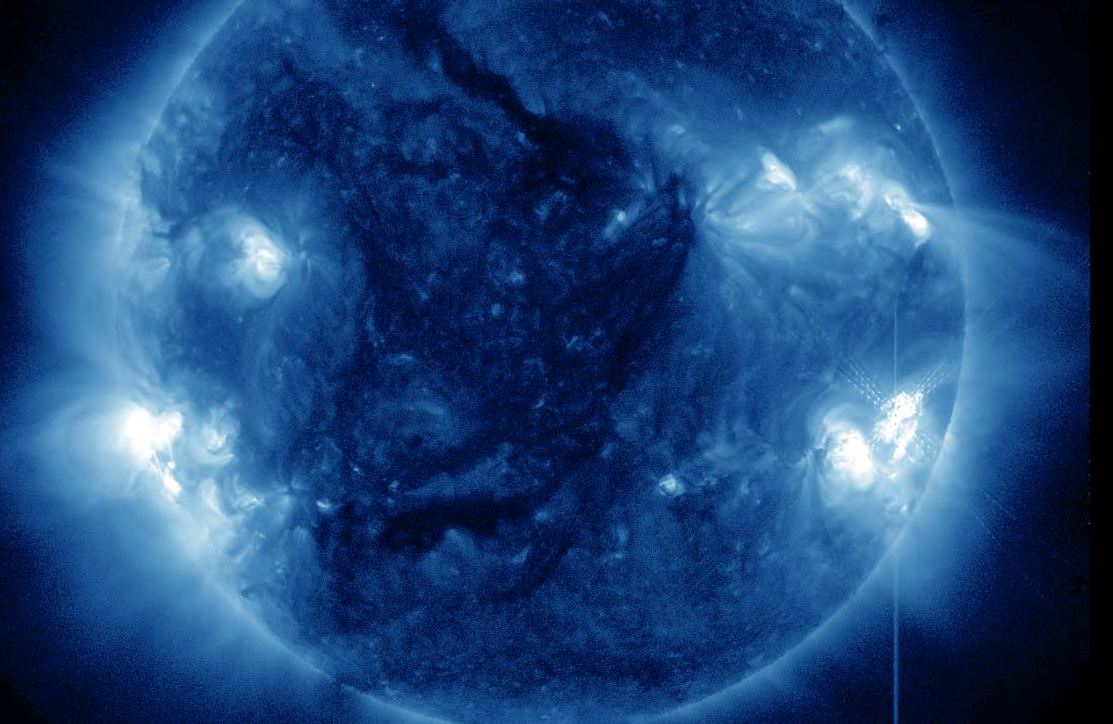An active region on the Sun, AR1515, has been putting on quite a show over the last 8 days, sending out all sorts of solar flares. Scientists were sure the huge sunspot was building up to produce an X-class explosion, and they were right. At 23:08 UT on July 6, 2012 it unleashed an X1-class solar flare. The explosion hurled a coronal mass ejection into space, and scientists say the cloud appears to be heading south and away from Earth; however, there is the possibility of a glancing blow to our planet on July 8th or 9th. There could be some auroral activity today, July 7, from a previous batch of CME’s hurled from the same active region.
According to the Solar Dynamics Observatory team, the movie above shows the X1 flare in various different wavelengths, which show different layers and temperatures. Each segment is about 30 minutes in real-time.
Below is another video from July 5-6, where AR1515 pulsed with with C- and M-class solar flares, about 14 flares in all:
Here’s an image of the action from SDO, with lots of activity going on:
“X1-class solar flare on the right, new active region on the left. Will the action continue?” asked Camilla_SDO, the mascot for the Solar Dynamics Observatory, via Twitter.
So, what’s the difference in the classes of solar flares and how could they affect us on Earth?
Flares happen when the powerful magnetic fields in and around the Sun reconnect. They’re usually associated with active regions, which we call sunspots, where the magnetic fields are strongest.
Flares are classified according to their strength. The smallest ones are B-class, followed by C, M and X, the largest. Similar to the Richter scale for earthquakes, each letter represents a ten-fold increase in energy output. So an X is 10 times an M and 100 times a C. Within each letter class, there is a finer scale from 1 to 9. Although X is the last letter, there are flares more than 10 times the power of an X1, so X-class flares can go higher than 9.
C-class flares are too weak to noticeably affect Earth. M-class flares can cause brief radio blackouts at the poles and minor radiation storms that might endanger astronauts. The most powerful flare on record was in 2003, during the last solar maximum. It was so powerful that it overloaded the sensors measuring it. They cut-out at X28. A powerful X-class flare like that can create long lasting radiation storms, which can harm satellites and even give airline passengers, flying near the poles, small radiation doses. X flares also have the potential to create global transmission problems and world-wide blackouts.
That’s why we keep an eye on all this activity.
Sources: SDO, Spaceweather.com


Yeah, don’t tan yourself on your balcony from 11AM to 15PM. 😀 Z-100 might hit you.
Sol is deflecting more cosmic rays as the solar maximum increases. But still, that gleam, glimmer or ‘sparkle’ in your lover’s eye may simply be a reflection..
Where is south in space?
That part of space which can be viewed from Down Under.
Maybe a better question would be, is there more south than north in space? Wouldn’t that depend entirely on where you were? i.e. on the North Pole the compass can only point south.
I’ve been watching AR1515… and had to notice that this complex of spots were very similar in shape to the previous group and that both of them looked amazingly similar to the Hawaiian Islands! An interesting coincidence…. Aloha Pele~
NASA astronauts Ed Lu and Michael Foale were aboard the ISS on Oct. 28, 2003 as were Russian cosmonauts Yuri Malenchenko and and Alexander Kaleri when that big flare/CME hit. I seem to remember they had to ‘hide out’ behind some equipment or in their Soyuz’s? I wonder if there were any repercussions health-wise for these gentlemen?
Aloha Pele continued. This next group ’rounding the bend’ today, is what? 180 degrees opposed to that last group? Looks like the projection of the ends of a twirling magnetic tornado on either side of Sol?
What would be way double extre groovy cool.. would be if you guys extended the weekly on-line astronomy to include 24/7(?) solar obs. by amateurs? Are there enough of them (us) out there to co-ordinate something like that? Bet we could get some groovy science going on… I am visualizing an approved list of contributors, no moderation.. cept as circumstances dictate…